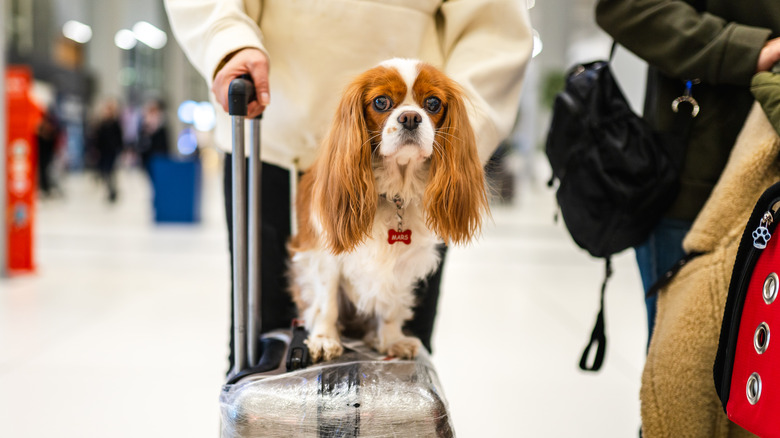What TSA Wants You To Know Before Flying With Your Pet
It's hard to imagine traveling by air without a run-in with TSA — and yes, that includes those self-service screenings — but we often forget that this government agency is relatively young, having only been around since 2001. Its primary mission is to keep everyone safe, and that includes your pets. With more people jet-setting with their four-legged friends, TSA has to screen them, too. And while most pets are inherently good (why else would TSA have working dogs?), they still have to follow rules to sail past security, just like us humans. Rule number one? Put them in proper carriers.
"TSA recognizes that for many pet owners, their animals are an extension of their family and they want to travel together," Anne Cross, TSA Deputy Federal Security Director for Colorado, explained. "Becoming familiar with the screening procedures and how to clear security quickly and easily is the first step to embarking on a great trip with your pet."
When going through security checkpoints, TSA advises pet parents to house them in hand-held travel carriers. Major airlines like United, American Airlines, and JetBlue have their own requirements for these bags, but generally, the best pet carriers for air travel need to be compact enough to fit under the seat in front of you. When it comes time for the actual screening, though, the advice is clear: carry your pet or keep them on a leash. But whatever you do, don't even think about subjecting them to the X-ray machine.
No, your pet doesn't have to go through the X-ray machine
While pets also have to go through security checks, they don't have to endure the X-ray machine along with your other belongings. Unless your pet is battery-powered (which, we hope, it isn't), TSA explicitly states in its guidelines that pets should not be placed in those scanners. "The main thing to know about traveling through a security checkpoint with your pet is to know that they should never be screened through a checkpoint X-ray unit," Jeffrey Horowitz, TSA's Assistant Federal Security Director for Norfolk International Airport, noted in a memo. "Only your veterinarian should be exposing your pet to X-rays."
Surprisingly, some travelers still forget this and send their poor pets through the X-ray tunnel with everyone else's junk. According to TSA, you should instead bring your pet with you through the metal detectors, either by carrying them or using a leash. Once you're through, a TSA officer will swab your hands to check for traces of explosives before you and Fido are free to go.
Got an extra fussy pet? No worries, you always have the option to do an alternative screening method. "If your pet is skittish, then you'll want to request screening in a private screening room," TSA spokesperson Lisa Farbstein told WGRZ. "That way if the pet wiggles or scratches or bites or nips and hops down on the floor, it's not to run away because it'll be contained in a private screening room."
The TSA advises pet owners to prep their furry friends well in advance
Traveling with your pet can be a breeze if you put in a little prep work ahead of time. If stepping into an airport is overwhelming for you, just imagine how they would feel if you threw them into that chaos without any preparation. TSA suggests that before your trip, you should help your pet to get used to staying inside their carrier. This way, they can be as calm and cozy as possible at the airport and during the flight. Laura MacLean, medical director at VCA Old Town Animal Hospital, told The Washington Post that pet parents should consider "leaving it out and open in the home to allow the pet to go in and out at their leisure to become accustomed to it."
When you finally reach security and find that there's a working TSA dog in the area, do yourself (and everyone else) a favor and switch to a different lane to avoid disrupting them as they do their jobs. And to kickstart the perfect vacation for your dog (or cat), know where the pet relief areas are in the airport before you get there, so you can give them a break when needed. "Some of ours are made to look like they're in an outdoor setting or a park, so the passenger and the animal feel more comfortable in their surroundings," Sarah McKeon, general manager of New Jersey airports, shared with the outlet.
